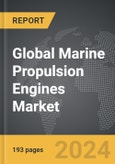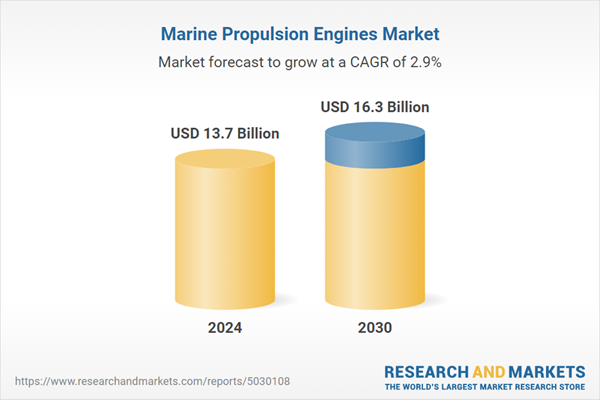The global market for Marine Propulsion Engines was valued at US$13.7 Billion in 2024 and is projected to reach US$16.3 Billion by 2030, growing at a CAGR of 2.9% from 2024 to 2030. This comprehensive report provides an in-depth analysis of market trends, drivers, and forecasts, helping you make informed business decisions. The report includes the most recent global tariff developments and how they impact the Marine Propulsion Engines market.
Segments: Engine Type (Diesel Engine, Gas Turbine, Natural Gas Engine, Other Engine Types); Application (Commercial, Naval, Off-Shore, Recreational, Other Applications).
Geographic Regions/Countries: World; United States; Canada; Japan; China; Europe (France; Germany; Italy; United Kingdom; Spain; Russia; and Rest of Europe); Asia-Pacific (Australia; India; South Korea; and Rest of Asia-Pacific); Latin America (Argentina; Brazil; Mexico; and Rest of Latin America); Middle East (Iran; Israel; Saudi Arabia; United Arab Emirates; and Rest of Middle East); and Africa.
The analysts continuously track trade developments worldwide, drawing insights from leading global economists and over 200 industry and policy institutions, including think tanks, trade organizations, and national economic advisory bodies. This intelligence is integrated into forecasting models to provide timely, data-driven analysis of emerging risks and opportunities.
Global Marine Propulsion Engines Market - Key Trends & Drivers Summarized
What Are Marine Propulsion Engines and Why Are They Essential to Maritime Operations?
Marine propulsion engines are the primary power sources that drive ships and other maritime vessels across oceans, seas, and inland waterways. These engines, ranging from diesel and gas turbines to nuclear and hybrid systems, provide the thrust necessary for a wide variety of vessels, including cargo ships, tankers, fishing boats, and passenger liners. The performance, reliability, and fuel efficiency of propulsion engines are critical to the operational success of maritime industries, as they directly impact vessel speed, maneuverability, and fuel consumption. With the maritime sector being the backbone of global trade, marine propulsion engines are essential for ensuring timely deliveries and cost-effective operations. As environmental regulations tighten, there is an increasing demand for propulsion systems that not only deliver power but also reduce emissions and improve fuel efficiency.How Are Technological Advancements Transforming Marine Propulsion Engines?
Technological advancements are revolutionizing marine propulsion engines, focusing on fuel efficiency, emissions reduction, and alternative energy sources. Innovations in hybrid and dual-fuel engines are gaining traction, allowing ships to switch between traditional fuels like diesel and cleaner alternatives such as liquefied natural gas (LNG). This flexibility is particularly important in meeting the International Maritime Organization’s (IMO) regulations on emissions, including the 2020 sulfur cap. Additionally, electric propulsion systems are becoming more viable for certain vessel types, offering lower emissions, reduced noise, and improved fuel efficiency. Advances in engine design, such as the use of lightweight materials and digital control systems, are enhancing the power-to-weight ratio and enabling smarter, more efficient propulsion. Research into hydrogen and ammonia-fueled engines is also gaining momentum, as the industry seeks long-term, zero-emission solutions for powering large vessels.What Challenges Does the Marine Propulsion Engines Market Face?
The marine propulsion engines market faces several challenges, particularly regarding the need for compliance with environmental regulations, the cost of new technologies, and the global shift toward greener energy sources. The IMO’s stringent emissions regulations are driving the need for engines that meet new sulfur and greenhouse gas (GHG) limits, which requires substantial investment in engine upgrades or replacements. The high cost of developing and adopting alternative fuel propulsion systems, such as LNG or hydrogen-based engines, presents a significant barrier for many shipowners. Additionally, the infrastructure required to support alternative fuels - such as LNG refueling stations or hydrogen bunkering facilities - remains underdeveloped in many parts of the world. Furthermore, the marine industry must balance the need for powerful engines capable of long-distance voyages with the growing demand for fuel-efficient and environmentally friendly solutions, which often require trade-offs in terms of cost and performance.Growth in the Marine Propulsion Engines Market Is Driven by Several Factors
The growth in the marine propulsion engines market is driven by several factors, including advancements in engine technology, increasing global trade, and rising demand for fuel-efficient and environmentally compliant vessels. As international shipping volumes continue to grow, there is a corresponding increase in the demand for more efficient and powerful propulsion systems that can handle larger vessels and longer voyages. Technological innovations, such as hybrid and dual-fuel engines, are helping the industry meet emissions regulations while improving operational efficiency. Additionally, the focus on developing alternative propulsion systems, including electric and hydrogen-based engines, is expected to further drive market growth as the maritime industry seeks to reduce its environmental footprint. These factors, along with the growing trend of digitalization and automation in marine propulsion, are expected to fuel continued expansion in the global marine propulsion engines market.Report Scope
The report analyzes the Marine Propulsion Engines market, presented in terms of units. The analysis covers the key segments and geographic regions outlined below.Segments: Engine Type (Diesel Engine, Gas Turbine, Natural Gas Engine, Other Engine Types); Application (Commercial, Naval, Off-Shore, Recreational, Other Applications).
Geographic Regions/Countries: World; United States; Canada; Japan; China; Europe (France; Germany; Italy; United Kingdom; Spain; Russia; and Rest of Europe); Asia-Pacific (Australia; India; South Korea; and Rest of Asia-Pacific); Latin America (Argentina; Brazil; Mexico; and Rest of Latin America); Middle East (Iran; Israel; Saudi Arabia; United Arab Emirates; and Rest of Middle East); and Africa.
Key Insights:
- Market Growth: Understand the significant growth trajectory of the Diesel Engine segment, which is expected to reach US$11.5 Billion by 2030 with a CAGR of a 2.8%. The Gas Turbine segment is also set to grow at 3.9% CAGR over the analysis period.
- Regional Analysis: Gain insights into the U.S. market, valued at $3.7 Billion in 2024, and China, forecasted to grow at an impressive 4.3% CAGR to reach $3.2 Billion by 2030. Discover growth trends in other key regions, including Japan, Canada, Germany, and the Asia-Pacific.
Why You Should Buy This Report:
- Detailed Market Analysis: Access a thorough analysis of the Global Marine Propulsion Engines Market, covering all major geographic regions and market segments.
- Competitive Insights: Get an overview of the competitive landscape, including the market presence of major players across different geographies.
- Future Trends and Drivers: Understand the key trends and drivers shaping the future of the Global Marine Propulsion Engines Market.
- Actionable Insights: Benefit from actionable insights that can help you identify new revenue opportunities and make strategic business decisions.
Key Questions Answered:
- How is the Global Marine Propulsion Engines Market expected to evolve by 2030?
- What are the main drivers and restraints affecting the market?
- Which market segments will grow the most over the forecast period?
- How will market shares for different regions and segments change by 2030?
- Who are the leading players in the market, and what are their prospects?
Report Features:
- Comprehensive Market Data: Independent analysis of annual sales and market forecasts in US$ Million from 2024 to 2030.
- In-Depth Regional Analysis: Detailed insights into key markets, including the U.S., China, Japan, Canada, Europe, Asia-Pacific, Latin America, Middle East, and Africa.
- Company Profiles: Coverage of players such as American Honda Motor Co., Inc., C W F Hamilton & Co Limited, Caterpillar, Inc., China Deyuan Marine Fitting Co., Ltd., Cox Powertrain Ltd. and more.
- Complimentary Updates: Receive free report updates for one year to keep you informed of the latest market developments.
Some of the 44 companies featured in this Marine Propulsion Engines market report include:
- American Honda Motor Co., Inc.
- C W F Hamilton & Co Limited
- Caterpillar, Inc.
- China Deyuan Marine Fitting Co., Ltd.
- Cox Powertrain Ltd.
- Cummins, Inc.
- Daihatsu Diesel Mfg. Co., Ltd.
- Fairbanks Morse
- Farymann North America
- Finning International Inc.
Tariff Impact Analysis: Key Insights for 2025
Global tariff negotiations across 180+ countries are reshaping supply chains, costs, and competitiveness. This report reflects the latest developments as of April 2025 and incorporates forward-looking insights into the market outlook.The analysts continuously track trade developments worldwide, drawing insights from leading global economists and over 200 industry and policy institutions, including think tanks, trade organizations, and national economic advisory bodies. This intelligence is integrated into forecasting models to provide timely, data-driven analysis of emerging risks and opportunities.
What’s Included in This Edition:
- Tariff-adjusted market forecasts by region and segment
- Analysis of cost and supply chain implications by sourcing and trade exposure
- Strategic insights into geographic shifts
Buyers receive a free July 2025 update with:
- Finalized tariff impacts and new trade agreement effects
- Updated projections reflecting global sourcing and cost shifts
- Expanded country-specific coverage across the industry
Table of Contents
I. METHODOLOGYII. EXECUTIVE SUMMARY2. FOCUS ON SELECT PLAYERSIII. MARKET ANALYSISCANADAITALYSPAINRUSSIAREST OF EUROPESOUTH KOREAREST OF ASIA-PACIFICARGENTINABRAZILMEXICOREST OF LATIN AMERICAIRANISRAELSAUDI ARABIAUNITED ARAB EMIRATESREST OF MIDDLE EASTIV. COMPETITION
1. MARKET OVERVIEW
3. MARKET TRENDS & DRIVERS
4. GLOBAL MARKET PERSPECTIVE
UNITED STATES
JAPAN
CHINA
EUROPE
FRANCE
GERMANY
UNITED KINGDOM
ASIA-PACIFIC
AUSTRALIA
INDIA
LATIN AMERICA
MIDDLE EAST
AFRICA
Companies Mentioned (Partial List)
A selection of companies mentioned in this report includes, but is not limited to:
- American Honda Motor Co., Inc.
- C W F Hamilton & Co Limited
- Caterpillar, Inc.
- China Deyuan Marine Fitting Co., Ltd.
- Cox Powertrain Ltd.
- Cummins, Inc.
- Daihatsu Diesel Mfg. Co., Ltd.
- Fairbanks Morse
- Farymann North America
- Finning International Inc.
Table Information
| Report Attribute | Details |
|---|---|
| No. of Pages | 193 |
| Published | April 2025 |
| Forecast Period | 2024 - 2030 |
| Estimated Market Value ( USD | $ 13.7 Billion |
| Forecasted Market Value ( USD | $ 16.3 Billion |
| Compound Annual Growth Rate | 2.9% |
| Regions Covered | Global |









